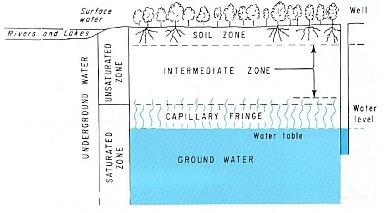Basic Groundwater Hydrology
| Topics: |
Geology (main)
|
Basic Ground-water Hydrology
Ground-water hydrology is the subdivision of the science of hydrology that deals with the occurrence, movement, and quality of water beneath the Earth's surface. It is interdisciplinary in scope in that it involves the application of the physical, biological, and mathematical sciences. It is also a science whose successful application is of critical importance to the welfare of mankind. Because ground-water hydrology deals with the occurrence and movement of water in an almost infinitely complex subsurface environment, it is, in its most advanced state, one of the most complex of the sciences. On the other hand, many of its basic principles and methods can be understood readily by nonhydrologists and used by them in the solution of ground-water problems.
The purpose of this report is to present these basic aspects of ground-water hydrology in a form that will encourage more widespread understanding and use.
The ground-water environment is hidden from view except in caves and mines, and the impression that we gain even from these are, to a large extent, misleading. From our observations on the land surface, we form an impression of a "solid" Earth. This impression is not altered very much when we enter a limestone cave and see water flowing in a channel that nature has cut into what appears to be solid rock. In fact, from our observations, both on the land surface and in caves, we are likely to conclude that ground water occurs only in underground rivers and "veins." We do not see the myriad openings that exist between the grains of sand and silt, between particles of clay, or even along the fractures in granite. Consequently, we do not sense the presence of the openings that, in total volume, far exceed the volume of all caves.
R. L. Nace of the U.S. Geological Survey has estimated that the total volume of subsurface openings (which are occupied mainly by water, gas, and petroleum) is on the order of 521,000 km3 (125,000 mi 3 ) beneath the United States alone. If we visualize these openings as forming a continuous cave beneath the entire surface of the United States, its height would be about 57 m (186 ft). The openings, of course, are not equally distributed, the result being that our imaginary cave would range in height from about 3 m (10 ft) beneath the Piedmont Plateau along the eastern seaboard to about 2,500 m (8,200 ft) beneath the Mississippi Delta.
The important point to be gained from this discussion is that the total volume of openings beneath the surface of the United States, and other land areas of the world, is very large. Most subsurface openings contain water, and the importance of this water to mankind can be readily demonstrated by comparing its volume with the volumes of water in other parts of the hydrosphere. Estimates of the volumes of water in the hydrosphere have been made by the Russian hydrologist M. I. L'vovich and are given in a book recently translated into English. Most water, including that in the oceans and in the deeper subsurface openings, contains relatively large concentrations of dissolved minerals and is not readily usable for essential human needs. We will, therefore, concentrate in this discussion only on freshwater. The accompanying table contains L'vovich's estimates of the freshwater in the hydrosphere.
Not surprisingly, the largest volume of freshwater occurs as ice in glaciers. On the other hand, many people impressed by the "solid" Earth are surprised to learn that about 14 percent of all freshwater is ground water and that, if only water is considered, 94 percent is ground water.
Ground-water hydrology, as noted earlier, deals not only with the occurrence of underground water but also with its movement. Contrary to our impressions of rapid movement as we observe the flow of streams in caves, the movement of most ground water is exceedingly slow. The truth of this observation becomes readily apparent from the table, which shows, in the last column, the rate of water exchange or the time required to replace the water now contained in the listed parts of the hydrosphere. It is especially important to note that the rate of exchange of 280 years for fresh ground water is about 119,000 the rate of exchange of water in rivers.
Subsurface openings large enough to yield water in a usable quantity to wells and springs underlie nearly every place on the land surface and thus make ground water one of the most widely available natural resources. When this fact and the fact that ground water also represents the largest reservoir of freshwater readily available to man are considered together, it is obvious that the value of ground water, in terms of both economics and human welfare, is incalculable. Consequently, its sound development, diligent conservation, and consistent protection from pollution are important concerns of everyone.
These concerns can be translated into effective action only by increasing our knowledge of the basic aspects of ground-water hydrology.
Editor's Note
- The Author is Ralph C. Heath.
- Click the Link to the right to download and read the Full Report.
